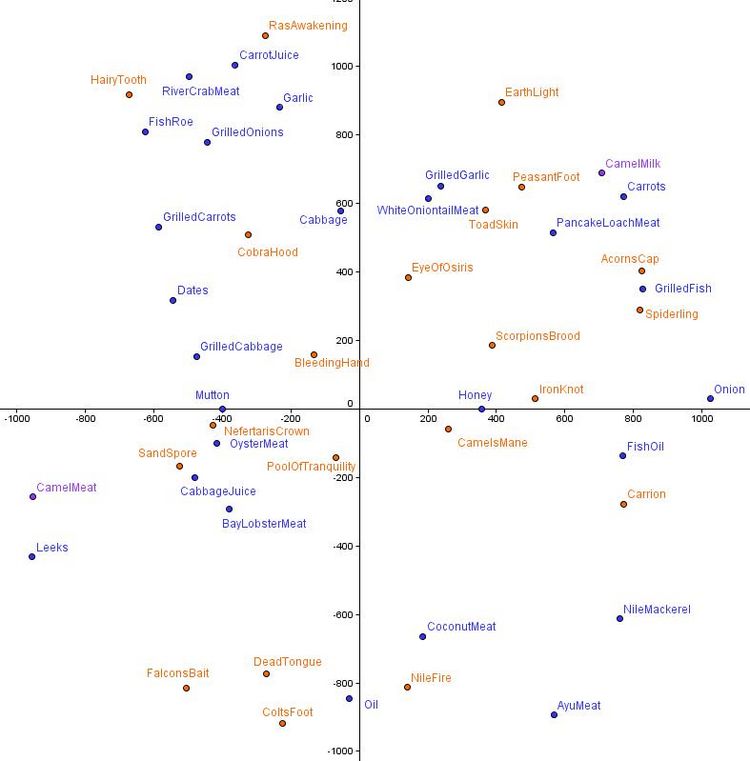The Wiki for Tale 5 is in read-only mode and is available for archival and reference purposes only. Please visit the current Tale 11 Wiki in the meantime.
If you have any issues with this Wiki, please post in #wiki-editing on Discord or contact Brad in-game.
User:Arame/Cooking
Cooking Data
At this point, I've gotten the basic coordinate map done, with the common ingredients mapped out, as well as a few fish and a good number of mushrooms. I'll be starting on herbs shortly. I haven't transcribed all this stuff over to a wiki table yet, but it should be out in the next day or two.
What I need
If folks want to donate resources, I'm always happy to take them. Primarily, I'm using a lot of cabbage, mutton, honey, and carrots in my testing. While those are generally pretty easy to keep in stock, I use anywhere from 6 to 20 of each for testing one new coordinate, so they do move quick. Otherwise, if you see fish or mushrooms that aren't on the coordinate list, I need anywhere from 4-10db to successfully test a new item. My camp is at about (525, -1400) in Sterope.
Basics Tested
- Cabbage
- Carrots
- Garlic
- Leeks
- Onions
- Grilled Cabbage
- Grilled Carrots
- Grilled Garlic
- Grilled Onions
- Cabbage Juice
- Carrot Juice
- Camel Meat
- Camel Milk
- Mutton
- Oyster Meat
- Grilled Fish
- Oil
- Fish Oil
- Fish Roe
- Honey
- Dates
Fish Tested
- Ayu
- Bay Lobster
- Nile Mackerel
- Pancake Loach
- River Crab
- White Oniontail
- Carp
- Catfish
- Abdju
- Chromis
- Perch
- Phagrus
- Tilapia
Mushrooms Tested
- Acorns Cap
- Bleeding Hand
- Camels Mane
- Carrion
- Cobra Hood
- Colts FOot
- Dead Tongue
- Earth Light
- Eye of Osiris
- Falcons Bait
- Hairy Tooth
- Iron Knot
- Nefertaris Crown
- Nile Fire
- Peasant Foot
- Pool of Tranquility
- Ras Awakening
- Razors Edge
- Sand Spore
- Scorpions Brood
- Spiderling
- Toad Skin
Actual Coordinate Map
This is being confirmed by other testers, but in the mean time, here are the coords for the first few basic ingredients. More to come.
The Spreadsheets
Here's the source file with the GeoGebra file, the Cooking spreadsheet (for single-pair tests), and the CookingWorksheet (for the duration/bulk/distance calculations). These will not be updated frequently, and expect the Cooking spreadsheet to fall off completely later on.
Same as last tale, I'm having trouble getting this in a readable format to most people. Bear with me, I'm working on it!
File:Arame CookingData Publish1.rar
How To Run Tests
There's a decent amount of math involved in cooking tests, but once you have the formula, it's relatively simplistic. For the basic testing, we need to find the relationship between our test subject and three or four known ingredients. For me, I use Honey, Mutton, and Cabbage to start with, and then replace failed reactions (negative times) with other ingredients. You'll run every test at a 6:1 ratio for these three ingredients, and then you'll pick the closest one (longest duration), and also test that at 13:1. Record everything in your own single-pair worksheet - you'll want it later on in your cooking career.
For testing, we then plug the data into a spreadsheet with the following formulas:

The columns are:
- Base : pretty explanatory, the base you're using in your 6:1 or 13:1 relationship.
- Additive : the ingredient we're testing.
- 7Dur : the duration of the 6:1 test. When you enter this, enter min*60 + sec, so that it's extremely easy to check.
- 14Dur : the duration of the 13:1 test. Same format as 7Dur.
- Potency = Dur Difference *14 : =(7Dur-14Dur)*14 [on my spreadsheet : (C2-D2)*14 ]
- Bulk = Duration7 - 1/7(Potency) : =7Dur - (Potency/7) [ C2 - (E2/7) ]
- Distance = 1000 - Bulk: =1000-Bulk [1000 - F2]
